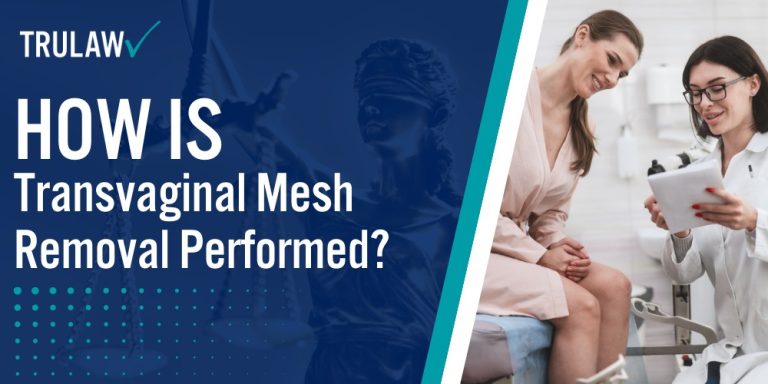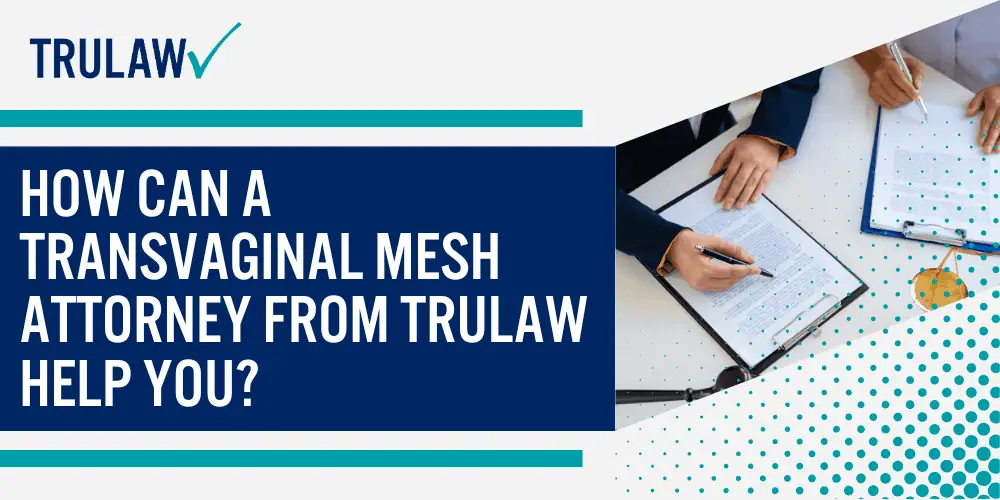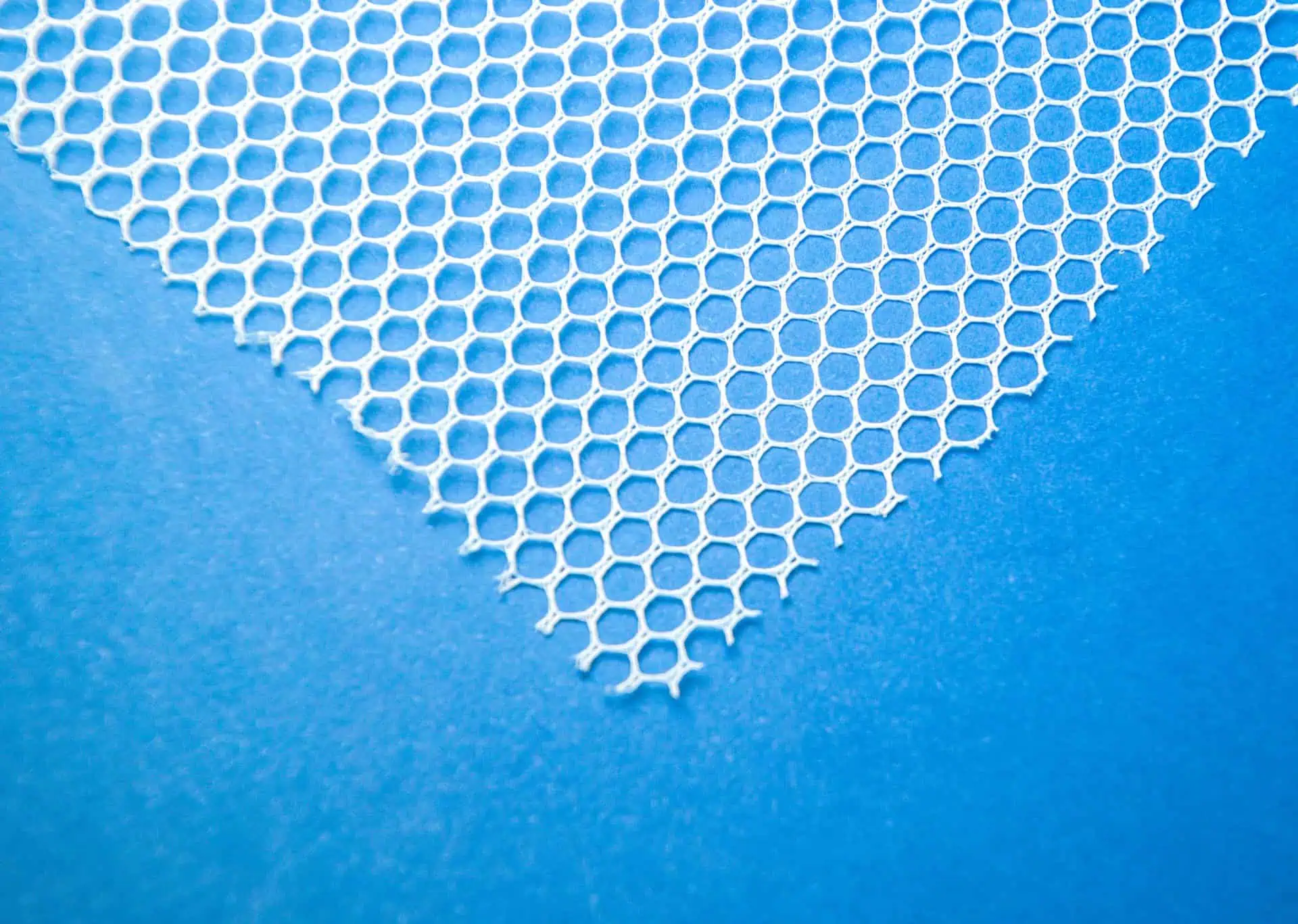How Is Transvaginal Mesh Removal Performed?
- Last Updated: June 12th, 2025

Attorney Jessica Paluch-Hoerman, founder of TruLaw, has over 28 years of experience as a personal injury and mass tort attorney, and previously worked as an international tax attorney at Deloitte. Jessie collaborates with attorneys nationwide — enabling her to share reliable, up-to-date legal information with our readers.
Legally Reviewed
This article has been written and reviewed for legal accuracy and clarity by the team of writers and legal experts at TruLaw and is as accurate as possible. This content should not be taken as legal advice from an attorney. If you would like to learn more about our owner and experienced injury lawyer, Jessie Paluch, you can do so here.
Fact-Checked
TruLaw does everything possible to make sure the information in this article is up to date and accurate. If you need specific legal advice about your case, contact us by using the chat on the bottom of this page. This article should not be taken as advice from an attorney.
Key takeaways:
- Urogynecologists typically perform transvaginal mesh removal to address complications like chronic pain, infection, bleeding, pain during intercourse, and mesh exposure through the vagina.
- Recovery time after complete transvaginal mesh removal surgery generally ranges from four to six weeks, with procedures potentially performed as outpatient treatments with local anesthetic or same-day surgery.
- Multiple surgical approaches exist for transvaginal mesh removal, including vaginal procedures, laparoscopic methods for bladder erosion cases, and newer robot-assisted techniques that aim to improve safety and efficacy.
How Is Transvaginal Mesh Removal Performed?
Question: How is transvaginal mesh removal performed?
Answer: Transvaginal mesh removal is a surgical procedure performed to address complications from previously implanted mesh.
The process typically involves making an incision in the vagina to access and carefully remove as much of the mesh as possible while minimizing damage to surrounding tissues and organs.
On this page, we’ll answer this question in further depth, exploring surgical removal techniques for transvaginal mesh, recovery after transvaginal mesh removal surgery, and much more.

Medical Complications That Lead to Mesh Removal
Transvaginal mesh removal becomes necessary when women experience complications from mesh implants used to treat pelvic organ prolapse or stress urinary incontinence.
These complications include mesh erosion through the vaginal wall, persistent pain, infection, painful intercourse, organ perforation, and urinary problems.
Physicians diagnose these issues through physical examination, imaging studies, and evaluation of patient symptoms before determining if complete or partial mesh removal is the appropriate treatment option.
TruLaw is actively assisting women filing transvaginal mesh lawsuits nationwide.
If you or someone you love has experienced complications related to vaginal mesh removal, you may qualify to seek compensation.
Contact TruLaw using the chat on this page to receive an instant case evaluation that can determine your eligibility to join others in filing a Transvaginal Mesh Lawsuit today.
Table of Contents
How Can A Transvaginal Mesh Attorney from TruLaw Help You?
Our Transvaginal Mesh attorney at TruLaw is dedicated to supporting clients through the process of filing a Transvaginal Mesh lawsuit.
With extensive experience in product liability cases, Jessica Paluch-Hoerman and our partner law firms work with litigation leaders and medical experts to prove how defective mesh implants caused you harm.
TruLaw focuses on securing compensation for medical expenses, revision surgeries, pain and suffering, lost income, and other damages resulting from your transvaginal mesh injuries.

We understand the physical and emotional toll that Transvaginal Mesh complications have on your life and provide the personalized guidance you need when seeking justice.
Meet the Lead Transvaginal Mesh Attorney at TruLaw
Meet our lead Transvaginal Mesh attorney:
- Jessica Paluch-Hoerman: As founder and managing attorney of TruLaw, Jessica brings her experience in product liability and personal injury to her client-centered approach by prioritizing open communication and personalized attention with her clients. Through TruLaw and partner law firms, Jessica has helped collect over $3 billion on behalf of injured individuals across all 50 states through verdicts and negotiated settlements.
How much does hiring a Transvaginal Mesh lawyer from TruLaw cost?
At TruLaw, we believe financial concerns should never stand in the way of justice.
That’s why we operate on a contingency fee basis—with this approach, you only pay legal fees after you’ve been awarded compensation for your injuries.
If you or a loved one experienced pain, bleeding, infection, organ perforation, mesh erosion, or other complications from transvaginal mesh implants, you may be eligible to seek compensation.
Contact TruLaw using the chat on this page to receive an instant case evaluation and determine whether you qualify to join others in filing a Transvaginal Mesh lawsuit today.
Preparing for Transvaginal Mesh Removal Surgery
Before undergoing transvaginal mesh removal surgery, patients typically undergo comprehensive pre-surgical testing and evaluations to ensure they’re properly prepared for the procedure.

These evaluations are important because mesh removal is a difficult procedure with success rates and complications varying depending on the type of mesh originally implanted and how long it has been in place.
Pre-Surgical Testing and Evaluations
Most surgeons require patients to stop smoking at least 6-8 weeks before surgery, as smoking can significantly impact healing and increase surgical complications.
Depending on individual health factors, the anesthesiologist may contact patients before surgery to ensure they’re healthy enough for the procedure.

The pre-surgical process generally includes:
- A detailed physical examination to assess the extent of mesh complications
- Urodynamic testing to evaluate bladder function and identify any urinary issues
- Cystoscopy or other imaging tests to determine if the mesh has eroded into the bladder or other organs
- Blood tests to check overall health status and rule out infection
- Urine culture to identify any existing urinary tract infections that need treatment before surgery
- Review of medications to identify those that may need to be temporarily discontinued (particularly blood thinners)
- An anesthesia consultation to determine the most appropriate anesthesia type based on medical history
Discussing Expectations and Recovery Timeline
Patients should understand that mesh removal surgery may not resolve all symptoms immediately.
While many women experience significant relief from pain, discomfort, and other complications, some symptoms may persist or take time to improve.
Setting realistic expectations is crucial when preparing for transvaginal mesh removal surgery.
During pre-surgical consultations, surgeons should clearly discuss:
- The likelihood of complete versus partial mesh removal (complete removal may not be possible if the mesh was placed using trocars or has significantly integrated with surrounding tissue)
- Potential complications specific to each patient’s situation
- Expected pain levels and pain management options
Patients should understand that mesh removal surgery may not resolve all symptoms immediately.
While many women experience significant relief from pain, discomfort, and other complications, some symptoms may persist or take time to improve.
The recovery process typically includes:
- Initial follow-up within 10-14 days to check incision healing
- Secondary follow-up at 3-6 weeks to assess overall recovery
- Final follow-up at 3-6 months to evaluate long-term outcomes
Patients should discuss with their surgeons how to prepare their home environment for recovery, including arranging for assistance with daily activities for the first few days after surgery.
For those traveling for specialized mesh removal surgery, accommodations should be arranged for at least 11-14 days to allow for the initial follow-up appointment before returning home.
TruLaw: Accepting Clients for the Transvaginal Mesh Lawsuit
Transvaginal mesh lawsuits are being filed by women across the country who suffered serious complications from pelvic mesh implants used to treat pelvic organ prolapse and stress urinary incontinence.
TruLaw is currently accepting clients for the Transvaginal Mesh lawsuit.
A few reasons to choose TruLaw for your Transvaginal Mesh lawsuit include:
- If We Don’t Win, You Don’t Pay: The Transvaginal Mesh lawyers at TruLaw and our partner firms operate on a contingency fee basis, meaning we only get paid if you win.
- Expertise: We have decades of experience handling product liability cases similar to the Transvaginal Mesh lawsuit.
- Successful Track Record: TruLaw and our partner law firms have helped our clients recover billions of dollars in compensation through verdicts and negotiated settlements.
If you or a loved one suffered pain, infection, bleeding, organ damage, or other complications after receiving a transvaginal mesh implant, you may be eligible to seek compensation.
Contact TruLaw using the chat on this page to receive an instant case evaluation that can determine if you qualify for the Transvaginal Mesh lawsuit today.
Transvaginal Mesh Lawsuit Frequently Asked Questions
-
Transvaginal mesh removal is a surgical procedure performed to address complications from previously implanted mesh.
The process typically involves making an incision in the vagina to access and carefully remove as much of the mesh as possible while minimizing damage to surrounding tissues and organs.
-
Recovery following transvaginal mesh removal typically takes four to six weeks.
During this time, patients should limit physical activities and follow their surgeon’s post-operative instructions carefully.
For cases where mesh has extruded into the urethra, recovery may take longer and require additional follow-up care.
-
Potential complications from transvaginal mesh removal include persistent pain, bleeding, infection, and urinary problems.
Some patients may experience temporary or long-term sexual dysfunction, vaginal scarring, or recurrence of the original condition that the mesh was intended to treat.
-
Key symptoms suggesting transvaginal mesh complications include chronic pelvic pain, pain during intercourse (dyspareunia), vaginal bleeding or discharge, recurrent urinary tract infections, and visible or palpable mesh through the vaginal wall.
Some patients may also experience urinary problems like frequency, urgency, or incontinence.
-
Transvaginal mesh removal surgery is performed under anesthesia, so patients are comfortable during the procedure.
Post-operative pain varies significantly between individuals, with most experiencing moderate discomfort for 1-2 weeks.
Pain management typically includes prescription medications initially, followed by over-the-counter options as healing progresses.
-
Success of transvaginal mesh removal depends on several factors, including the extent of mesh integration with surrounding tissues, the surgeon’s experience with transvaginal mesh cases, whether complete or partial removal is performed, the patient’s overall health, and the presence of pre-existing damage to surrounding organs or tissues.
-
Finding a qualified surgeon for transvaginal mesh removal requires researching specialists with specific experience in mesh complications and removal procedures.
Look for urogynecologists or reconstructive urologists at academic medical centers, get referrals from your primary care physician, and verify the surgeon has performed numerous mesh removal surgeries with documented outcomes.

Managing Attorney & Owner
With over 25 years of legal experience, Jessica Paluch-Hoerman is an Illinois lawyer, a CPA, and a mother of three. She spent the first decade of her career working as an international tax attorney at Deloitte.
In 2009, Jessie co-founded her own law firm with her husband – which has scaled to over 30 employees since its conception.
In 2016, Jessie founded TruLaw, which allows her to collaborate with attorneys and legal experts across the United States on a daily basis. This hypervaluable network of experts is what enables her to share the most reliable, accurate, and up-to-date legal information with our readers!
Additional Transvaginal Mesh Lawsuit resources on our website:
Here, at TruLaw, we’re committed to helping victims get the justice they deserve.
Alongside our partner law firms, we have successfully collected over $3 Billion in verdicts and settlements on behalf of injured individuals.
Would you like our help?
At TruLaw, we fiercely combat corporations that endanger individuals’ well-being. If you’ve suffered injuries and believe these well-funded entities should be held accountable, we’re here for you.
With TruLaw, you gain access to successful and seasoned lawyers who maximize your chances of success. Our lawyers invest in you—they do not receive a dime until your lawsuit reaches a successful resolution!
AFFF Lawsuit claims are being filed against manufacturers of aqueous film-forming foam (AFFF), commonly used in firefighting.
Claims allege that companies such as 3M, DuPont, and Tyco Fire Products failed to adequately warn users about the potential dangers of AFFF exposure — including increased risks of various cancers and diseases.
Depo Provera Lawsuit claims are being filed by individuals who allege they developed meningioma (a type of brain tumor) after receiving Depo-Provera birth control injections.
A 2024 study found that women using Depo-Provera for at least 1 year are five times more likely to develop meningioma brain tumors compared to those not using the drug.
Suboxone Tooth Decay Lawsuit claims are being filed against Indivior, the manufacturer of Suboxone, a medication used to treat opioid addiction.
Claims allege that Indivior failed to adequately warn users about the potential dangers of severe tooth decay and dental injuries associated with Suboxone’s sublingual film version.
Social Media Harm Lawsuits are being filed against social media companies for allegedly causing mental health issues in children and teens.
Claims allege that companies like Meta, Google, ByteDance, and Snap designed addictive platforms that led to anxiety, depression, and other mental health issues without adequately warning users or parents.
Transvaginal Mesh Lawsuits are being filed against manufacturers of transvaginal mesh products used to treat pelvic organ prolapse (POP) and stress urinary incontinence (SUI).
Claims allege that companies like Ethicon, C.R. Bard, and Boston Scientific failed to adequately warn about potential dangers — including erosion, pain, and infection.
Bair Hugger Warming Blanket Lawsuits involve claims against 3M — alleging their surgical warming blankets caused severe infections and complications (particularly in hip and knee replacement surgeries).
Plaintiffs claim 3M failed to warn about potential risks — despite knowing about increased risk of deep joint infections since 2011.
Baby Formula NEC Lawsuit claims are being filed against manufacturers of cow’s milk-based baby formula products.
Claims allege that companies like Abbott Laboratories (Similac) and Mead Johnson & Company (Enfamil) failed to warn about the increased risk of necrotizing enterocolitis (NEC) in premature infants.
Here, at TruLaw, we’re committed to helping victims get the justice they deserve.
Alongside our partner law firms, we have successfully collected over $3 Billion in verdicts and settlements on behalf of injured individuals.
Would you like our help?
